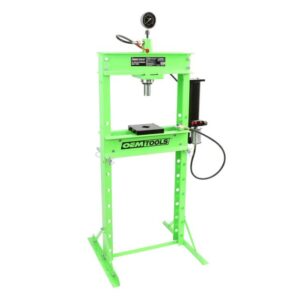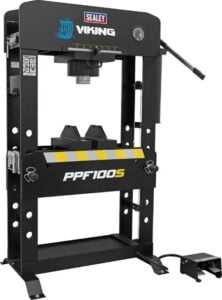Air presses are tools used in many industrial and manufacturing processes. They play a crucial role in various applications that require the compression of air or gas. An air press is a mechanical device designed to generate high-pressure air by converting kinetic energy into potential energy.
The compressed air can then be used for various purposes, such as powering pneumatic tools, controlling automated machines, and even providing breathable air in underwater environments.
The development of air presses can essentially be traced back to the 17th century when a scientist named Otto von Guericke invented the first vacuum pump. This laid the foundation for further advancements in the field of air compression and led to the creation of modern-day air presses.
How an Air Press Works
An air press operates based on the simple principle of pneumatics, that is, using the energy stored in compressed air to perform work. Here’s a detailed step-by-step breakdown of how this process unfolds:
Air Intake
The process begins when the air compressor sucks in air from its surroundings. This air is usually drawn in through a filter to ensure its purity and to protect the internal components of the air press from potential damage.
Compression
The air that is drawn in is then squeezed or compressed in a compression chamber. Depending on the type of air press, the compression might be carried out in one or more stages. In each stage, the air is compressed and then cooled to reduce the temperature that rises due to compression.
Storage
The compressed air is then stored in a high-pressure tank, ready to be used. A pressure switch monitors the pressure in the tank, and when it drops below a certain level, the compressor kicks in again to refill the tank.
Dispersion
When the air press is put to work, compressed tank air is released from the tank. The energy from this compressed air is then used to power various pneumatic devices or tools.
Exhaust
After the compressed air has done its job, it is expelled as exhaust air and the process starts over again.
Note: Remember, the efficiency and effectiveness of an air press depend on a number of factors, including the quality of the air intake, the efficiency of the compression, and the capacity of the storage tank. Regular maintenance and checks can ensure the air press performs optimally and lasts longer.
Components and Design of an Air Press

An air press is composed of various components, each with a specific role in the process of compression and storage. Some of the key components include:
Air Intake: This is where the air press draws in external air for compression. It is important to ensure that the air intake is clean and free of any contaminants to avoid damage to the internal components.
Compression Chamber: This is where the actual compression of air takes place. The chamber must be designed to withstand high pressures and temperatures, as well as dissipate heat effectively.
Cooling System: As the air is compressed, it heats up and must be cooled before being stored. A cooling system helps maintain safe temperatures inside the air press.
Pressure Switch: This component monitors the pressure in the storage tank and triggers the compressor to refill when necessary. This helps maintain a consistent level of compressed air.
Storage Tank: The storage tank is where the compressed air is stored and available for use. It must be designed to withstand high pressures and have appropriate safety measures in place.
Safety Valve: In case of excess pressure build-up, a safety valve releases the air to prevent damage or explosion. This is an important safety feature in an air press.
Drain Valve: As compressed air contains moisture, a drain valve allows for the removal of any accumulated water to maintain the quality of the stored air.
Control Panel: The control panel is where the user can monitor and adjust settings for the air press. It may also include features such as pressure gauges, temperature sensors, and automation controls.
Types of Air Presses
There are several types of air presses available, including reciprocating, rotary screw, and scroll compressors. Each type has its own advantages and suitability for different applications.
1. Reciprocating Air Presses
Reciprocating air presses, also known as piston air presses, work similarly to a car engine. They use pistons which move up and down inside cylinders to compress the air. When the piston moves down, it creates a vacuum effect that sucks in air. As the piston moves up, it compresses the air.
This compressed air is then pushed into the storage tank, ready for use. Reciprocating air presses are commonly found in applications requiring lower volumes of air at high pressures, such as in home garages and small workshops. One key advantage of reciprocating air presses is their simplicity and ease of maintenance.
2. Rotary Screw Air Presses
Rotary screw air presses use two helical screws to compress the air. These screws rotate in opposite directions, trapping and compressing the air between them. This continuous process allows for a steady supply of compressed air with minimal pulsations.
Rotary screw air presses are commonly used in industrial settings that require a high volume of compressed air at constant pressure, such as in manufacturing plants and large workshops. They also have the advantage of being quieter and more energy-efficient than reciprocating air presses.
3. Scroll Air Presses
Scroll air presses use two spiral-shaped scrolls to compress the air. These scrolls interlock and rotate, creating a smaller and smaller pocket of trapped air until it reaches the desired pressure. Once this pressure is reached, the compressed air is released from an outlet valve.
Scroll air presses are commonly used in applications that require clean and oil-free compressed air, such as in medical settings or laboratory equipment. Their compact size and low maintenance make them a popular choice for these types of applications.
Common Applications of Air Presses
Aside from the common industrial and workshop applications, air presses have a wide range of uses in various industries. They are often used in pneumatic tools such as drills, impact wrenches, and spray guns.
In the automotive industry, they are essential for operating brakes and suspension systems. Air presses are also utilized in food and beverage processing, pharmaceutical manufacturing, and even in aviation for controlling aircraft landing gear.
Benefits of Using an Air Press

There are many advantages to using air presses over other methods of pressurizing, such as hydraulic or electric systems.
Cost-Effective
Air presses are relatively inexpensive to operate and maintain compared to other pressurization methods. They require minimal energy consumption and have a long lifespan, making them a cost-effective choice for businesses.
Versatile
Air presses can handle a wide range of pressures and are adaptable to various applications. They can deliver high pressure for heavy-duty tasks or low pressure for delicate operations, making them highly versatile in different industries.
Safe and Clean
Air presses are a safer option compared to hydraulic systems, which use oil that can be hazardous in the event of leaks. They also produce clean, oil-free compressed air, making them ideal for applications where contamination is a concern.
Easy to Use
Air presses are user-friendly and straightforward to operate, making them suitable for a range of skill levels. They also have quick response times, allowing for efficient and precise operations.
Maintenance Tips for Air Presses
To ensure the longevity and optimal performance of an air press, regular maintenance is necessary. Here are some essential maintenance tips for air presses:
- Check the air filter regularly and replace it if dirty or clogged to ensure clean, efficient operation.
- Inspect the air compressor for any signs of wear and tear, such as leaks or abnormal noises, and address them promptly to prevent further damage.
- Keep the air press well-lubricated by regularly checking and refilling oil levels according to the manufacturer’s recommendations.
- Check all connections and hoses for any signs of wear or damage, such as cracks or leaks, and replace them if necessary to maintain optimal pressurization.
- Clean the air press regularly to prevent dust and debris buildup that can affect performance and cause malfunctions.
Conclusion
Air presses are versatile, safe, and easy to use machines that can benefit various industries. With regular maintenance and proper care, they can provide efficient and reliable performance for a long time. Regularly following these maintenance tips will help keep your air press in optimal condition and ensure its longevity. So, make sure to incorporate them into your routine to get the most out of your air press.

